#st. francis of assisi roman catholic church
Text

#st. francis of assisi#catholic saint quotes#catholic saints#catholic#catholicism#christian quotes#tradcath#god#saints#jesus christ#trad catholic#traditional media#traditional catholicism#traditional illustration#roman catholicism#catholiscism#catholic church#catholism#catholic tumblr#catholic art#Saint Francis#saint francis of assisi#dove
2 notes
·
View notes
Text
Give a meaningful voice to people and planet





Here is my small contribution to World Environment Day. As Saint Francis of Assisi once said: "Start by doing what's necessary; then do what's possible and suddenly you are doing the impossible."
#world environment day#manchester#uk#iraq#iraqi#environment#hussein al-alak#st francis of assisi#united nations#roman catholic#roman catholic church#planet earth
0 notes
Text
Talking to some friends about how the Roman Catholic church/school I went to celebrated the feast day of St. Francis of Assisi by allowing us to bring our pets to class and get them blessed by the priest when we went for prayer. Did any other Catholics have Bring Your Pet To School To Get Holy Water Wiped On Them Day? Was this unique to my religious experience.
I took my turtle by the way. What a confusing day for a box turtle
#religion#st. francis of assisi#When I was confirmed I picked St. Francis as my patron saint. This surprised literally nobody#pissed my mom off tho
5 notes
·
View notes
Text
SAINT OF THE DAY (April 2)

Catholics will remember St. Francis of Paola on April 2.
The saint founded a religious order at a young age and sought to revive the practices of the earliest monks during a period of corruption in the Church.
Francis was born in the Southern Italian region of Calabria on 27 March 1416. His parents, who maintained a strong devotion to St. Francis of Assisi, named their son after him.
The boy's father and mother had little in the way of wealth, but they passed on a rich spiritual heritage to their son, with the hope that he would imitate his namesake.
The young Francis showed signs of a remarkable spiritual life, following his parents' lead in accepting poverty as a path to holiness.
When his father placed him in the care of a group of Franciscan friars to be educated at the age of 13, Francis made a personal decision to live strictly according to the rule of their religious order.
After a year with the friars, Francis rejoined his parents as they made a pilgrimage to Assisi in Rome and the historic Franciscan church known as the Portiuncula.
When the family returned to their hometown of Paola, Francis – at the age of only 15 – asked his parents' permission to live as a hermit, in the manner of the earliest desert fathers such as St. Anthony of Egypt.
The young monk slept in a cave and ate what he could gather in the wild, along with occasional offerings of food from his friends in the town.
Within four years, two companions had joined him. The townspeople assisted in building three individual cells for the hermits, as well as a chapel where a priest would offer Mass.
With approval from the local archbishop, this small group continued to grow into a larger religious order, without compromising the young founder's insistence on penitential and primitive living conditions.
They were first known as the Hermits of St. Francis of Assisi but later renamed the “Minimi” (or “Minims”), meaning “the least,” and signifying their commitment to humility.
Francis and his monks were notable not only for their austere lifestyle but also for their strict diet, which not only eliminated meat and fish, but also excluded eggs, dairy products, and other foods derived from animals.
Abstinence from meat and other animal products became a “fourth vow” of his religious order, along with the traditional vows of poverty, chastity and obedience.
Francis instituted the continual, year-round observance of this diet in an effort to revive the tradition of fasting during Lent, which many Roman Catholics had ceased to practice by the 15th century.
Ironically, Francis' pursuit of solitary communion with God attracted attention from a range of important figures, including several European kings and other nobility along with Popes and bishops.
Some of these men regarded Francis as a spiritual leader in a corrupt age, while others may have been more interested in his gifts of prophecy and miraculous healing.
Francis traveled to France at the request of Pope Sixtus IV, taking with him his nephew Nicholas, whom he had raised from the dead.
There, the notoriously power-hungry King Louis XI was approaching the point of death himself.
He hoped that Francis would perform a miracle and restore his health.
Francis told the king bluntly that he should not fear the end of his earthly life, but the loss of eternal life.
From that time, the hermit became a close spiritual adviser to the king.
He discussed the reality of death and eternity with him, and urged him to surrender his heart and soul to God before it was too late.
The king died in Francis' arms in 1483.
Louis XI's son and successor, Charles VIII, maintained the monk as a close adviser, in spiritual and even political affairs.
Nonetheless, Francis persisted in following the monastic rule he had developed while living in his hermitage outside of Paola.
He continued as superior general of the Minim Order and founded new monasteries in France.
Francis sensed that his death was approaching at the age of 91 and returned to living in complete solitude for three months to prepare himself.
When he emerged, he gathered a group of the Minim brothers and gave them final instructions for the future of the order.
He received Holy Communion for the last time and died on April 2, Good Friday of 1507.
He was beatified on 1 November 1518. Pope Leo X canonized him on 1 May 1519.
Although the Minim Order lost many of its monasteries in the 18th century during the French Revolution, it continues to exist, primarily in Italy.
Francis is said to have raised the dead; healed the sick and crippled; averted plagues; expelled demons; spoken prophetically to bishops, popes, and kings; and performed many other miracles.
He is the patron saint of Calabria, seafarers, boatmen, mariners, and naval officers.
2 notes
·
View notes
Text
Today the Church honors St. Francis of Assisi (1181-1226 AD), Deacon and Friar.
Ora pro nobis.
Saint Francis of Assisi was born Giovanni di Pietro di Bernardone, informally named as Francesco, meaning “little Frenchman, by his mother who was from France.. He was an Italian Catholic friar, deacon, and preacher. He founded the men's Order of Friars Minor, the women’s Order of Saint Clare, the Third Order of Saint Francis and the Custody of the Holy Land.
Pope Gregory IX canonized Francis on 16 July 1228. Along with Saint Catherine of Sienna, he was designated Patron saint of Italy.
He has become highly sentimentalized and trivialized in the 20th century, including being rebranded as the 'environmentalist saint' with patronage of animals. This should break our hearts. In his life, however, he was completely devoted to preaching the Gospel of Jesus Christ, the formation of disciples of Jesus, adoration of Jesus in the Blessed Sacrament, and for the care of the poor, homeless, and outcast lepers. As a Roman Catholic Franciscan friar friend of mine once preached in my parish, "Don't you dare make my Francis into a birdbath or relegate him to a tiny statue in your garden! He was a radical in his love for Jesus, the poor, and for preaching the Gospel!"
Speaking of things Francis never said, there’s a beautiful prayer, often called the “Prayer of St. Francis”. It is lovely on its own merits. It was written during WWI in 1912 for a French newspaper as a plea for peace. I love this prayer, and commend it to all for use in your life of prayer, as I do the radical discipleship of blessed Francis, who gave all to Jesus in service to the poor, lepers, and the conversion of all peoples.
"An example of this [sentimentalization and] misrepresentation of Francis is the phrase, "Preach the gospel everywhere; if necessary use words," which is often ascribed to Francis. It's a popular phrase. The problem is, there is no evidence Francis said it. It’s like saying, "Feed the hungry; if necessary use food." To honor St Francis, go to your local homeless shelter and offer a foot clinic, to bathe their feet and tend to their wounds; go volunteer at your local soup kitchen, and sit down with the folks who come and listen to them.
Of course, the wisdom of these particular sayings do not depend upon their source. Many of us have been on the receiving end of words spoken in the name of the gospel by someone whose life or attitude did not "preach" the gospel. Our lives must bear witness to the good news of Jesus before our words about that good news can make any sense. Francis did encourage Christians “to shine as an example to others.” But to suggest that the gospel can be preached without using words is deceptive. We ought to be able to tell the Gospel in a manner that makes the story of our lives make sense. That requires words as well as actions. Francis did in fact write, “Being the servant of all, I am bound to serve all and to administer the balm-bearing words of my Lord.” (Letter to all the Faithful)
In 1219 AD, he went to Egypt in an attempt to convert the Sultan to put an end to the conflict of the Crusades. His attempt failed, but the Sultan was so impressed by his holiness and love that he let him go home to Italy rather than imprisoning him for ransom or executing him as an infidel.
By this point, the Franciscan Order had grown to such an extent that its primitive organizational structure was no longer sufficient. He returned to Italy to organize the Order. Once his community was authorized by the Pope, he withdrew increasingly from external affairs. In 1223, Francis arranged for the first Christmas live nativity scene. According to Christian tradition, in 1224 he received the stigmata during the apparition of Seraphic angels in a religious ecstasy, making him the first recorded person in Christian history to bear the wounds of Christ's Passion.
He died during the evening hours of 3 October 1226, while listening to a reading he had requested of Psalm 142, exhausted and physically broken by his radical devotion, at the age of 45.
Blessed Francis, you challenge me, and even frighten me because you actually actually did what Jesus said, and so render my accomodations to this world and excuses for not giving up all to follow Jesus invalid. Pray for me.
Most high, omnipotent, good Lord, grant your people grace to renounce gladly the vanities of this world; that, following the way of blessed Francis, we may for love of you delight to give ourselves wholly unto the adoration of your blessed Son, our Savior Jesus, and to the preaching of his Gospel for the salvation of the world with perfectness of joy; through Jesus Christ our Lord, who lives and reigns with you and the Holy Spirit, one God, forever and ever.
Amen.
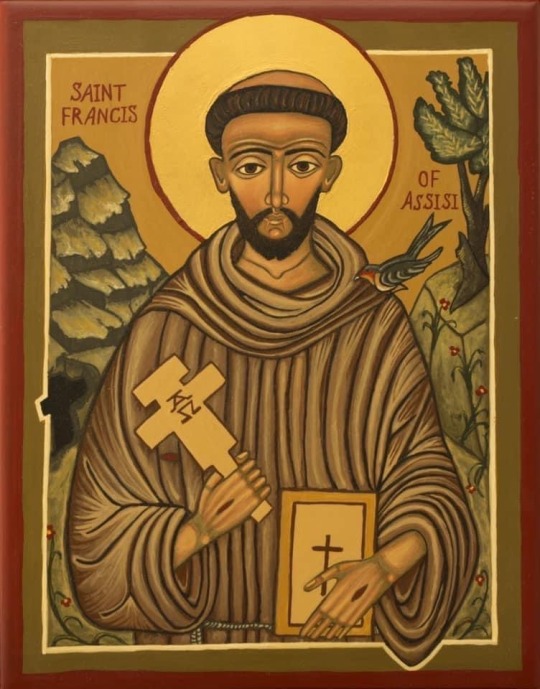
3 notes
·
View notes
Text

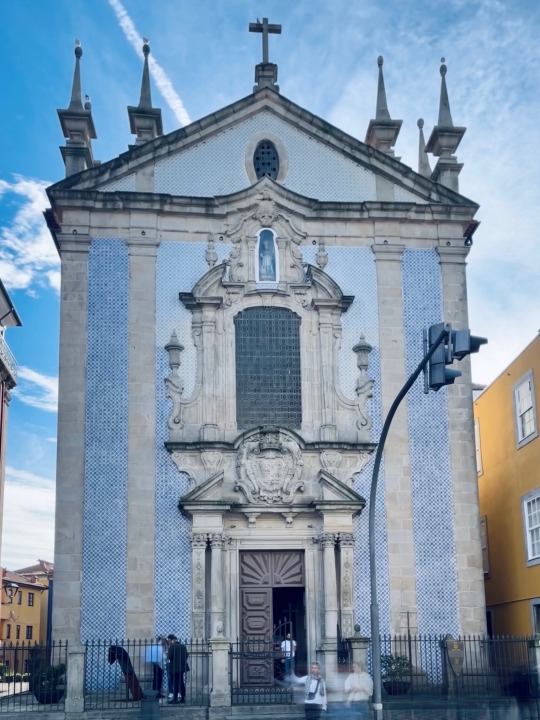
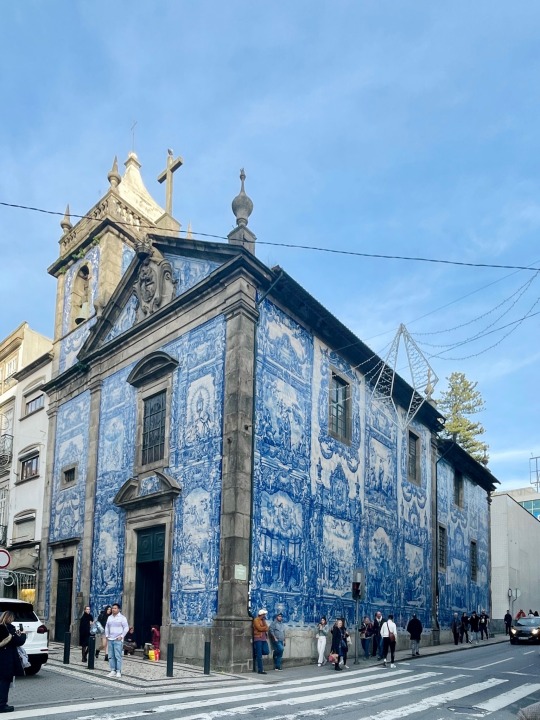

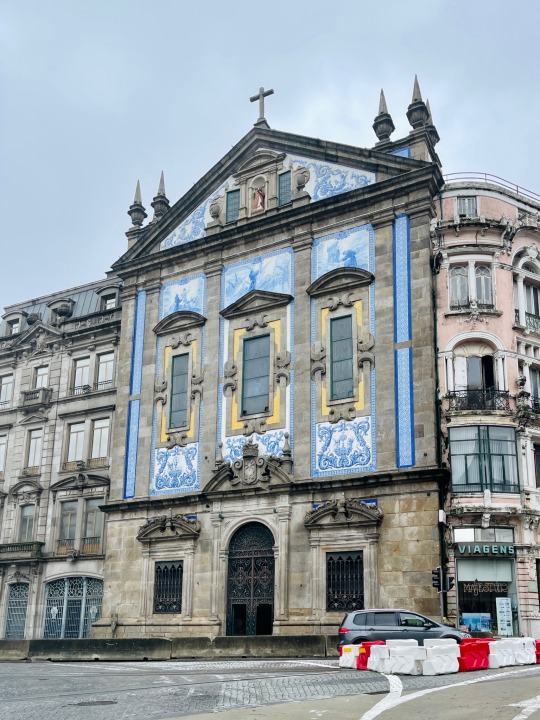
.
It’s Sunday so let’s share some beautiful Churches and their facade with azulejo tiles.
Azulejos have their origin in the Arabic word az-zillij meaning “polished stone.” King Manuel I introduced them into Portugal after a visit to Seville in 1503. The tin-glazed ceramics can be found in the interior and exterior of churches, palaces, ordinary houses and nowadays, restaurants bars and even railways or subways stations. Many azuléjos chronique major historical and cultural aspects of Spanish and Portuguese history.
1/ Igreja do Carmo (Carmo Chruch)… One of the oldest building in the historic part of Porto. It’s actually a combination of two buildings, one sating from the 1600s and the other from the 1700s. Originally it was builds for the Carmelite order of the Roman Catholic Church and was used as a convent.The exterior wall of the building is covered in tiles depicting the history of the Carmelite order
2/ Igreja Paroquial de Sao Nicolau (Parish Church of St Nicholas)… after a fire in 1758, the church was reconstructed in 1762 in a mixed Neoclassical and Baroque style. The facade was covered with tiles in 1861
3/ Capela Das Almas de Santa Caterina (Chapel of Souls)… The style of the church is basically neoclassical but the church is noted for its coverings of azulejo tiles. The 16,000 glowing blue and white tiles depicts scenes from the lives of Saint Catherine and Saint Francis of Assisi.
4/ Igreja de Santa Ildefonso (Church of Saint Ildefonso)… Constructed of granite, the shape of the church’s main body is that of a elongated octogone with decorative plater ceiling. Approximately 11,000 azulejo tiles cover the facade of the church which were created by artist Jorge Colaço and placed in novembre 1932. The tiles depict scenes from the life of Saint Illdefonso and figurative imagery from the Gospels.
5/ Igreja de Santo António dos Congregados (St Anthony’s Church of the Gatherers)… The church is dedicated to Saint Anthony of Padua. The building was constructed during the late part of the 17th century, The church replaced the original church a which stood on this land for several hundred years. The tiles work tells the story of St Anthony and the Asdsu;potion of the Blessed Virgin Mary.
9 notes
·
View notes
Photo

This celebration started among the world Orthodox Christian community in 1989 with the leadership of Ecumenical Patriarch Bartholomew, who is affectionately known as “the Green Patriarch.” For the Orthodox community in the United States, September 1 has significance beyond its proximity to back-to-school events and Labor Day weekend. It is the beginning of the Orthodox liturgical year. Patriarch Bartholomew issued an encyclical on September 1, 2015 to mark the occasion. In an ecumenical gesture of global significance, Pope Francis announced in August 2015 that the Roman Catholic Church will also recognize September 1 as the World Day of Prayer for the Care of Creation. Fr. John Chryssavgis, theological adviser to Patriarch Bartholomew and member of the ecumenical office of the Greek Orthodox Archdiocese of America, does not think it is coincidental “that Pope Francis and Ecumenical Patriarch Bartholomew are leaders in their respective churches at this critical moment when our response to the challenge of climate change demands shared responsibility and commitment." The call to prayer didn’t stop with the Orthodox and Catholic communities. Creation Justice Ministries issued a joint press release with the National Council of Churches USA celebrating Pope Francis’s ecumenical gesture, and encouraging broad ecumenical participation. October 4 marks the end of the Season of Creation. It is significant to Christians who observe the Feast of St. Francis of Assisi, the patron saint of living creatures. https://www.instagram.com/p/Ch9gMrNutPL/?igshid=NGJjMDIxMWI=
2 notes
·
View notes
Text
Holidays 11.16
Holidays
Birth of the Blues Day
Clarinet Day
Charles Bonnet Syndrome Day
Dagur Islenskrar Tungu (Icelandic Language Day; Iceland)
Day of Declaration of Sovereignty (Estonia)
Esme’s Umbrella Day
Flag Day (Benin)
Guinness World Record Day
Have a Party with Your Bear Day
Icelandic Language Day
International Check Your Wipers Day
International Day For Tolerance (UN)
International Day of Flamenco
International Selfie Day
International UNESCO World Heritage Day
Mother’s Day (North Korea)
National Andy Day
National Black Marketeers Day
National Button Day
National Charles Day
National Check Your Wipers Day
National Doctors’ Day (South Africa)
National Indiana Day
National Information & Referral Day
National Moms and Dads Day
National Press Day (India)
National Sarah Day
National Slobber Appreciation Day
Pistachio Day (French Republic)
Rage Against the Machine Day
Red Cup Day
Remembrance of Things Past Day
Resident Aliens' Day
Revolution Day (Mexico)
Social Enterprise Day
Statia Day (Bonaire, St. Eustatius & Saba)
World Acupuncture Awareness Day
World Chocolate Day
World Clarinet Day
World Falconry Day
World Historical Motors Day
World Horse Appreciation Day
World Idea Day
World mRNA Day
World Sanfilippo Awareness Day
Food & Drink Celebrations
Famous San Diego Chicken Day
Have a Party with Your Bear Day
National Fast Food Day
3rd Thursday in November
Beaujolais Nouveau Day [3rd Thursday]
Catholic School Appreciation Day [3rd Thursday]
Children’s Grief Awareness Day [3rd Thursday]
Educator For a Day [3rd Thursday]
Friendsgiving [3rd Thursday]
Give Miami Day (Florida) [3rd Thursday]
Great American Smokeout [3rd Thursday]
International Guinness Book of World Records Day [Thursday of 2nd Full Week]
International Guinness World Records Day [Thursday of 2nd Full Week]
Julia Child Day [3rd Thursday]
National Bundt Day (a.k.a. Bundt Pan Day) [3rd Thursday]
National Catholic School Principal’s Day [3rd Thursday]
National Parent Involvement Day [3rd Thursday]
National Rural Health Day [3rd Thursday]
National Thaw Day [3rd Thursday]
Social Enterprise Day [3rd Thursday]
Use Less Stuff Day [3rd Thursday]
World Pancreatic Cancer Day [3rd Thursday]
World Philosophy Day (UN) [3rd Thursday]
World's Biggest Liar Competition (UK; sponsored by Jennings Brewery) [3rd Thursday]
World Day for Clean Air [3rd Thursday]
World Wide Pressure Injury Prevention Day [3rd Thursday]
Independence Days
Adamburg (Declared; 2016) [unrecognized]
Oklahoma Statehood Day (#46; 1907)
Feast Days
Africus (Christian; Saint)
Agnes of Assisi (Christian; Saint)
Depoma Heklates (Night of the Crossroads; Pagan)
Dodo Grieving Day (Pastafarian)
Edmund of Abingdon (Christian; Saint)
Elfric of Abingdon (Christian; Saint)
Eucherius of Lyon (Christian; Saint)
Francis Danby (Artology)
Gertrude the Great (Roman Catholic Church)
Giuseppe Moscati (Christian; Saint)
Gobrain (Christian; Saint)
Hecate Night (Wicca)
Herschel Gordon Lewis Day (Church of the SubGenius; Saint)
Hugh of Lincoln (Roman Catholic Church)
Margaret of Scotland (Christian; Saint)
Matthew the Evangelist (Eastern Christianity)
Media Autumnus III (Pagan)
Mr. and Mrs. Slop (Muppetism)
Othmar (Christian; Saint)
Our Lady of the Gate of Dawn (Christian; Saint)
Roch Gonzalez, Juan de Castillo, and Alonso Rodriguez, SJ (Christian; Saint)
Ruyter (Positivist; Saint)
Lucky & Unlucky Days
Perilous Day (13th Century England) [29 of 32]
Sensho (先勝 Japan) [Good luck in the morning, bad luck in the afternoon.]
Premieres
Amélie (Film; 2001)
Anna Karenina (Film; 2012)
Beaned by a Blossom or The Petal Pushers (Rocky & Bullwinkle Cartoon, S6, Ep. 319; 1964)
Beowulf (Film; 2007)
Billboard Frolics (WB MM Cartoon; 1935)
A Clash of Kings, by George R.R. Martin (Novel; 1998) [A Song of Fire and Ice #1]
Close Encounters of the Third Kind (Film; 1977)
Cyrano de Bergerac (Film; 1990)
Donny & Marie (TV Variety Series; 1975)
Don’t Let Me Be Misunderstood, recorded by The Animals (Song; 1964)
Fantastic Beasts: The Crimes of Grindelwald (Film; 2018)
The 400 Blows (Film; 1959)
Harry Potter and the Sorcerer's Stone (Film; 2001) [Harry Potter #1]
Heavenly Creatures (Film; 1994)
Home Alone (Film; 1990)
House M.D. (TV Series; 2004)
I Fall to Pieces, recorded by Patsy Cline (Song; 1960)
Jingle All the Way (Film; 1996)
Just the Way You Are (Film; 1984)
Kangaroo Jack: G’Day U.S.A.! (WB Animated Film; 2004)
Lincoln (Film; 2012)
Little Women (Film; 1933)
The Lost Weekend (Film; 1945)
Love the One You’re With, by Stephen Stills (Song; 1970)
The Menu (Film; 2022)
More Than Human, by Theodore Sturgeon (Novel; 1953)
Mouse-Taken Identity (WB MM Cartoon; 1957)
Mr. Magorium’s Wonder Emporium (Film; 2007)
A Nightmare on Elm Street (Film; 1984)
Night of the Comet (Film; 1984)
The October Country, by Ray Bradbury (Short Stories; 1955)
Papillon, by Henri Charrière (Memoir; 1969)
The Prince and the Pauper (Disney Cartoon; 1990)
The Real Thing, by Tom Stoppard (Play; 1982)
The Rescuers Down Under (Disney Animated Film; 1990)
Rocky V (Film; 1990)
Silver Linings Playbook (Film; 2012)
The Sound of Music (Broadway Musical; 1959)
Stephen Stills, by Stephen Stills (Album; 1970)
Things Fall Apart, by Chinua Achebe (Novel; 1958)
Twilight Saga: Breaking Dawn, Part 2 (Film; 2012)
Vacation Daze or Visit to a Small Panic (Rocky & Bullwinkle Cartoon, S6, Ep. 320; 1964)
Today’s Name Days
Margareta, Otmar (Austria)
Matei (Bulgaria)
Agneta, Gertruda, Margareta (Croatia)
Otmar (Czech Republic)
Othenius (Denmark)
Aarne, Arne, Arno, Arnold (Estonia)
Aarne, Aarni, Aarno (Finland)
Gertrude, Marguerite, Mégane (France)
Arthur, Margarita, Otmar (Germany)
Ifigenia, Mathaios, Matthaios (Greece)
Ödön (Hungary)
Margherita, Procolo (Italy)
Banga, Dzirkstīte, Glorija (Latvia)
Edmundas, Gerdvilė, Gertrūda, Vaišvydas (Lithuania)
Edgar, Edmund (Norway)
Aureliusz, Dionizy, Edmund, Gertruda, Leon, Marek, Maria, Niedamir, Otomar, Paweł, Piotr (Poland)
Matei (Romania)
Agnesa (Slovakia)
Edmundo, Gertrudis, Margarita (Spain)
Vibeke, Viveka (Sweden)
Matthew (Ukraine)
Gertrude, Iris, Chase, Chasen, Trudy (USA)
Today is Also…
Day of Year: Day 320 of 2024; 45 days remaining in the year
ISO: Day 4 of week 46 of 2023
Celtic Tree Calendar: Ngetal (Reed) [Day 17 of 28]
Chinese: Month 10 (Gui-Hai), Day 4 (Wu-Yin)
Chinese Year of the: Rabbit 4721 (until February 10, 2024)
Hebrew: 3 Kislev 5784
Islamic: 3 Jumada I 1445
J Cal: 20 Mir; Sixday [20 of 30]
Julian: 3 November 2023
Moon: 12%: Waxing Crescent
Positivist: 12 Frederic (12th Month) [Ruyter]
Runic Half Month: Nyd (Necessity) [Day 6 of 15]
Season: Autumn (Day 54 of 89)
Zodiac: Scorpio (Day 24 of 29)
0 notes
Text
Holidays 11.16
Holidays
Birth of the Blues Day
Clarinet Day
Charles Bonnet Syndrome Day
Dagur Islenskrar Tungu (Icelandic Language Day; Iceland)
Day of Declaration of Sovereignty (Estonia)
Esme’s Umbrella Day
Flag Day (Benin)
Guinness World Record Day
Have a Party with Your Bear Day
Icelandic Language Day
International Check Your Wipers Day
International Day For Tolerance (UN)
International Day of Flamenco
International Selfie Day
International UNESCO World Heritage Day
Mother’s Day (North Korea)
National Andy Day
National Black Marketeers Day
National Button Day
National Charles Day
National Check Your Wipers Day
National Doctors’ Day (South Africa)
National Indiana Day
National Information & Referral Day
National Moms and Dads Day
National Press Day (India)
National Sarah Day
National Slobber Appreciation Day
Pistachio Day (French Republic)
Rage Against the Machine Day
Red Cup Day
Remembrance of Things Past Day
Resident Aliens' Day
Revolution Day (Mexico)
Social Enterprise Day
Statia Day (Bonaire, St. Eustatius & Saba)
World Acupuncture Awareness Day
World Chocolate Day
World Clarinet Day
World Falconry Day
World Historical Motors Day
World Horse Appreciation Day
World Idea Day
World mRNA Day
World Sanfilippo Awareness Day
Food & Drink Celebrations
Famous San Diego Chicken Day
Have a Party with Your Bear Day
National Fast Food Day
3rd Thursday in November
Beaujolais Nouveau Day [3rd Thursday]
Catholic School Appreciation Day [3rd Thursday]
Children’s Grief Awareness Day [3rd Thursday]
Educator For a Day [3rd Thursday]
Friendsgiving [3rd Thursday]
Give Miami Day (Florida) [3rd Thursday]
Great American Smokeout [3rd Thursday]
International Guinness Book of World Records Day [Thursday of 2nd Full Week]
International Guinness World Records Day [Thursday of 2nd Full Week]
Julia Child Day [3rd Thursday]
National Bundt Day (a.k.a. Bundt Pan Day) [3rd Thursday]
National Catholic School Principal’s Day [3rd Thursday]
National Parent Involvement Day [3rd Thursday]
National Rural Health Day [3rd Thursday]
National Thaw Day [3rd Thursday]
Social Enterprise Day [3rd Thursday]
Use Less Stuff Day [3rd Thursday]
World Pancreatic Cancer Day [3rd Thursday]
World Philosophy Day (UN) [3rd Thursday]
World's Biggest Liar Competition (UK; sponsored by Jennings Brewery) [3rd Thursday]
World Day for Clean Air [3rd Thursday]
World Wide Pressure Injury Prevention Day [3rd Thursday]
Independence Days
Adamburg (Declared; 2016) [unrecognized]
Oklahoma Statehood Day (#46; 1907)
Feast Days
Africus (Christian; Saint)
Agnes of Assisi (Christian; Saint)
Depoma Heklates (Night of the Crossroads; Pagan)
Dodo Grieving Day (Pastafarian)
Edmund of Abingdon (Christian; Saint)
Elfric of Abingdon (Christian; Saint)
Eucherius of Lyon (Christian; Saint)
Francis Danby (Artology)
Gertrude the Great (Roman Catholic Church)
Giuseppe Moscati (Christian; Saint)
Gobrain (Christian; Saint)
Hecate Night (Wicca)
Herschel Gordon Lewis Day (Church of the SubGenius; Saint)
Hugh of Lincoln (Roman Catholic Church)
Margaret of Scotland (Christian; Saint)
Matthew the Evangelist (Eastern Christianity)
Media Autumnus III (Pagan)
Mr. and Mrs. Slop (Muppetism)
Othmar (Christian; Saint)
Our Lady of the Gate of Dawn (Christian; Saint)
Roch Gonzalez, Juan de Castillo, and Alonso Rodriguez, SJ (Christian; Saint)
Ruyter (Positivist; Saint)
Lucky & Unlucky Days
Perilous Day (13th Century England) [29 of 32]
Sensho (先勝 Japan) [Good luck in the morning, bad luck in the afternoon.]
Premieres
Amélie (Film; 2001)
Anna Karenina (Film; 2012)
Beaned by a Blossom or The Petal Pushers (Rocky & Bullwinkle Cartoon, S6, Ep. 319; 1964)
Beowulf (Film; 2007)
Billboard Frolics (WB MM Cartoon; 1935)
A Clash of Kings, by George R.R. Martin (Novel; 1998) [A Song of Fire and Ice #1]
Close Encounters of the Third Kind (Film; 1977)
Cyrano de Bergerac (Film; 1990)
Donny & Marie (TV Variety Series; 1975)
Don’t Let Me Be Misunderstood, recorded by The Animals (Song; 1964)
Fantastic Beasts: The Crimes of Grindelwald (Film; 2018)
The 400 Blows (Film; 1959)
Harry Potter and the Sorcerer's Stone (Film; 2001) [Harry Potter #1]
Heavenly Creatures (Film; 1994)
Home Alone (Film; 1990)
House M.D. (TV Series; 2004)
I Fall to Pieces, recorded by Patsy Cline (Song; 1960)
Jingle All the Way (Film; 1996)
Just the Way You Are (Film; 1984)
Kangaroo Jack: G’Day U.S.A.! (WB Animated Film; 2004)
Lincoln (Film; 2012)
Little Women (Film; 1933)
The Lost Weekend (Film; 1945)
Love the One You’re With, by Stephen Stills (Song; 1970)
The Menu (Film; 2022)
More Than Human, by Theodore Sturgeon (Novel; 1953)
Mouse-Taken Identity (WB MM Cartoon; 1957)
Mr. Magorium’s Wonder Emporium (Film; 2007)
A Nightmare on Elm Street (Film; 1984)
Night of the Comet (Film; 1984)
The October Country, by Ray Bradbury (Short Stories; 1955)
Papillon, by Henri Charrière (Memoir; 1969)
The Prince and the Pauper (Disney Cartoon; 1990)
The Real Thing, by Tom Stoppard (Play; 1982)
The Rescuers Down Under (Disney Animated Film; 1990)
Rocky V (Film; 1990)
Silver Linings Playbook (Film; 2012)
The Sound of Music (Broadway Musical; 1959)
Stephen Stills, by Stephen Stills (Album; 1970)
Things Fall Apart, by Chinua Achebe (Novel; 1958)
Twilight Saga: Breaking Dawn, Part 2 (Film; 2012)
Vacation Daze or Visit to a Small Panic (Rocky & Bullwinkle Cartoon, S6, Ep. 320; 1964)
Today’s Name Days
Margareta, Otmar (Austria)
Matei (Bulgaria)
Agneta, Gertruda, Margareta (Croatia)
Otmar (Czech Republic)
Othenius (Denmark)
Aarne, Arne, Arno, Arnold (Estonia)
Aarne, Aarni, Aarno (Finland)
Gertrude, Marguerite, Mégane (France)
Arthur, Margarita, Otmar (Germany)
Ifigenia, Mathaios, Matthaios (Greece)
Ödön (Hungary)
Margherita, Procolo (Italy)
Banga, Dzirkstīte, Glorija (Latvia)
Edmundas, Gerdvilė, Gertrūda, Vaišvydas (Lithuania)
Edgar, Edmund (Norway)
Aureliusz, Dionizy, Edmund, Gertruda, Leon, Marek, Maria, Niedamir, Otomar, Paweł, Piotr (Poland)
Matei (Romania)
Agnesa (Slovakia)
Edmundo, Gertrudis, Margarita (Spain)
Vibeke, Viveka (Sweden)
Matthew (Ukraine)
Gertrude, Iris, Chase, Chasen, Trudy (USA)
Today is Also…
Day of Year: Day 320 of 2024; 45 days remaining in the year
ISO: Day 4 of week 46 of 2023
Celtic Tree Calendar: Ngetal (Reed) [Day 17 of 28]
Chinese: Month 10 (Gui-Hai), Day 4 (Wu-Yin)
Chinese Year of the: Rabbit 4721 (until February 10, 2024)
Hebrew: 3 Kislev 5784
Islamic: 3 Jumada I 1445
J Cal: 20 Mir; Sixday [20 of 30]
Julian: 3 November 2023
Moon: 12%: Waxing Crescent
Positivist: 12 Frederic (12th Month) [Ruyter]
Runic Half Month: Nyd (Necessity) [Day 6 of 15]
Season: Autumn (Day 54 of 89)
Zodiac: Scorpio (Day 24 of 29)
0 notes
Text
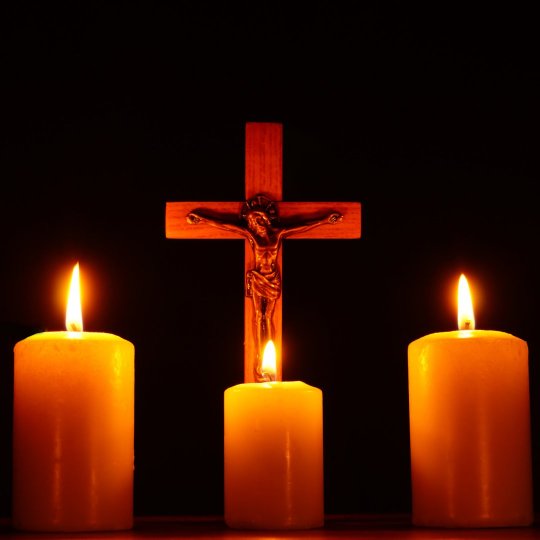
Saint of the day October 04
St. Peter of Damascus, Roman Catholic Priest and Martyr. The bishop of Damascus, Syria, at the time of the Islamic conquest of the region. He was seized by the Muslims for preaching against Muhammad and condemned to death. His captors tortured, blinded, crucified, and finally beheaded him. Feastday October 4
St. Adauctus, Roman Catholic Martyr. Adauctus, executed in Ephesus, was caught up in the persecutions of co-Emperor Maximinus Daia (r. 310-313). The Caesar or junior emperor of Syria and Egypt and a pagan who opposed the Church, Maximus Dala was halted in his persecutions by Constantine's Edict of Milan in 312.
Saint Petronius was bishop of Bologna during the fifth century. He is a patron saint of the city. Born of a noble Roman family, he became a convert to Christianity and subsequently a priest. As bishop of Bologna, he built the Church of Santo Stefano.
ST. FRANCIS OF ASSISI, FOUNDER OF THE FRANCISCAN ORDER, PATRON OF ITALY, He’s among the most loved Saints, remembered on 4 October. For over 800 years Saint Francis of Assisi has been a beacon for the Church through his witness to the Gospel earning him the name “alter Christus”, a living icon of Christ, his choice to live in poverty in order to encounter the Lord. St. Francis of Assisi, Roman Catholic friar and preacher. He founded the men's Order of Friars Minor, the women’s Order of St. Clare, and the Third Order of Saint Francis for men and women not able to live the lives of itinerant preachers followed by the early members of the Order of Friars Minor or the monastic lives of the Poor Clares.
0 notes
Text
Places You Should See in Vilnius - Part 2 (2/6)
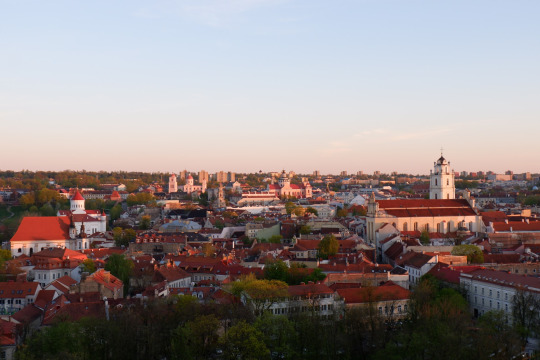
Welcome to the part 2 of Vilnius recommendations <3
1.6. Three Crosses (Trys Kryžiai) and Bernardine Park & (Bernardinų Sodas & Parkas)

After you visit the Museum of Applied Arts and Design you can keep walking and take a right turn or you can walk through Bernardine Park to reach the hill. Bernardine Park & Garden is just in between Gediminas Hill and the Bernardine Monastery. Right next to the park flows Vilnelė River. Three Crosses see the whole city! I like to visit the place at the sunset. The crosses are located in the Kalnų parkas.
1.7. Republic of Užupis ( Užupio Respublika)

The Republic of Užupis is an independent region in the center of Vilnius. The republic is quite unique. Don’t miss this must-see item when visiting Vilnius. Užupis proclaimed their independence in 1998. They are recognized by Lithuania and many other countries from the UK to Azerbaijan. Check their history here. The region is home to many art and design centers and streets are covered with great artwork and murals. I recommend entering Uzupio from Bernardinų Tiltas and getting out from Paupio Tiltas and visit these places and getting lost through the streets:
Jonas Mekas Visual Arts Center,
Bridge of Užupis (there is a pub near it and if you are lucky enough to find a seat, make sure to have a few drinks there)
Angel of Užupis,
Constitution of the Republic of Užupis.
1.8. St. Anne’s Church & St. Francis of Assisi (Bernardine) Roman Catholic Church

St. Anne’s Church (Vilniaus Šv. Onos bažnyčia ) and St. Francis of Assisi (Bernardine) Roman Catholic Church ( Vilniaus šv. Pranciškaus Asyžiečio (Bernardinų) parapija) are located near each other and you can easily reach them from the Cathedral Square or Bernardine Park and even it is close to the Uzupis. I highly recommend visiting inside the churches as they are greatly decorated. But keep in mind that, even on weekdays there are ceremonies in churches; so please be respectful.
Adam Bernard Mickiewicz is a national poet in Poland, Lithuania, and Belarus from Poland. Mickiewicz is not only a poet but also a dramatist, essayist, publicist, translator, and political activist. You can see his statue right next to the churches.
1.9. Pilies Street (Pilies Gatve)
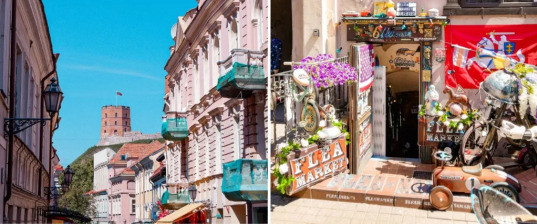
This street is one of the famous streets in Vilnius Old Town. It’s only 2 minutes walk away from the Vilnius Cathedral. When you enter the street you will see there local restaurants, great pubs, and souvenir stores. This street is perfect to dine and buy. You will understand what I mean when you see it.
On the street, coming from the Cathedral side, there is a little shop called Flea Market on the left side. Even though most recognize the shop quickly due to the colorful and crowded sill but some pass by as they are busy with other things. I believe the place needs special recognition on the list.
1.10. Gates of Dawn & The Church of St Theresa
Gates of Dawn (Aušros vartai) is a city gate that used to be a part of Vilnius’s defensive wall in the 16th century. The gate contains a famous Renaissance: The Blessed Virgin Mary. The painting is worshipped by Catholics, Russian Orthodox, and Greek Orthodox. Therefore the gate is known to be a prayer point among many.
If you walk down a bit towards the street you will find The Church of St Theresa (Vilniaus Šv. Teresės bažnyčia) dating back to the 16th century.

1.11. Church of St. Johns & The Bell Tower – Vilnius University
Vilnius University is one of the best universities in Vilnius and is the oldest university in the Baltic states. The university is centrally located and has hidden gems in it.

Church of St. Johns as short or the “Church of St. Johns, St. John the Baptist and St. John the Apostle and Evangelist” is located in the old town in Vilnius University’s garden. The church is simply beautiful. The Bell Tower of St. John’s Church nearby offers one of the best panoramic views you can get in the city. Definitely go up!
Vilnius University Library
Vilnius University Library or VU Library as most refers dates back to the 16th Century and actually 9 nine years older than the university itself. Also, it is the oldest academic library not only in Vilnius but in Lithuania. The original art on the walls and ceilings is very well preserved. It gave me Harry Potter vibes a bit probably because I have never seen such a library with such art.
0 notes
Text

St. Francis of Assisi Catholic Church, Kraków, Poland by Rod Herzstrom
#st. francis of assisi#catholic church#13th century#poland#central europe#kraków#krakow#travel#wanderlust#religious architecture#altar#catholic#roman catholic#basilica#europe#dark academia#dark acadamia aesthetic#Polish#wiara#Bóg
1K notes
·
View notes
Text
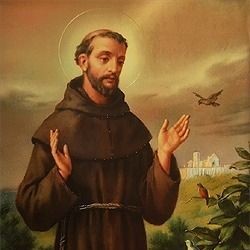
Men lose all the material things they leave behind them in this world, but they carry with them the reward of their charity and the alms they give. For these, they will receive from the Lord the reward and recompense they deserve.
St. Francis of Assisi
#st francis of assisi#god#follow me#jesuschrist#i need followers#faith#roman catholic#catholicism#god loves you#amen#faithful#polish blogger#igrejacatolica#Iglesia católica#catholic church#mary mother of jesus#quotes
11 notes
·
View notes
Text
SAINT OF THE DAY (April 2)
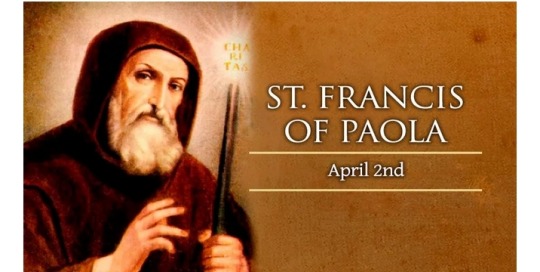
Catholics will remember St. Francis of Paola on April 2.
The saint founded a religious order at a young age and sought to revive the practices of the earliest monks during a period of corruption in the Church.
Francis was born in the Southern Italian region of Calabria during 1416. His parents, who maintained a strong devotion to St. Francis of Assisi, named their son after him.
The boy's father and mother had little in the way of wealth, but they passed on a rich spiritual heritage to their son, with the hope that he would imitate his namesake.
The young Francis showed signs of a remarkable spiritual life, following his parents' lead in accepting poverty as a path to holiness.
When his father placed him in the care of a group of Franciscan friars to be educated at the age of 13, Francis made a personal decision to live strictly according to the rule of their religious order.
After a year with the friars, Francis rejoined his parents as they made a pilgrimage to Assisi, Rome, and the historic Franciscan church known as the Portiuncula.
When the family returned to their hometown of Paola, Francis – at the age of only 15 – asked his parents' permission to live as a hermit, in the manner of the earliest desert fathers such as St. Anthony of Egypt.
The young monk slept in a cave and ate what he could gather in the wild, along with occasional offerings of food from his friends in the town.
Within four years, two companions had joined him. The townspeople assisted in building three individual cells for the hermits, as well as a chapel where a priest would offer Mass.
With approval from the local archbishop, this small group continued to grow into a larger religious order, without compromising the young founder's insistence on penitential and primitive living conditions.
They were first known as the Hermits of St. Francis of Assisi but later renamed the “Minimi” (or “Minims”), meaning “the least,” and signifying their commitment to humility.
Francis and his monks were notable not only for their austere lifestyle but also for their strict diet, which not only eliminated meat and fish, but also excluded eggs, dairy products, and other foods derived from animals.
Abstinence from meat and other animal products became a “fourth vow” of his religious order, along with the traditional vows of poverty, chastity and obedience.
Francis instituted the continual, year-round observance of this diet in an effort to revive the tradition of fasting during Lent, which many Roman Catholics had ceased to practice by the 15th century.
Ironically, Francis' pursuit of solitary communion with God attracted attention from a range of important figures, including several European kings and other nobility along with popes and bishops.
Some of these men regarded Francis as a spiritual leader in a corrupt age, while others may have been more interested in his gifts of prophecy and miraculous healing.
Francis traveled to France at the request of Pope Sixtus IV, taking with him his nephew Nicholas, whom he had raised from the dead.
There, the notoriously power-hungry King Louis XI was approaching the point of death himself. He hoped that Francis would perform a miracle and restore his health.
Francis told the king bluntly that he should not fear the end of his earthly life but the loss of eternal life.
From that time, the hermit became a close spiritual adviser to the king. He discussed the reality of death and eternity with him. He urged him to surrender his heart and soul to God before it was too late.
The king died in Francis' arms in 1483.
Louis XI's son and successor, Charles VIII, maintained the monk as a close adviser in spiritual and even political affairs.
Nonetheless, Francis persisted in following the monastic rule he had developed while living in his hermitage outside of Paola.
He continued as superior general of the Minim Order and founded new monasteries in France.
Francis sensed that his death was approaching at the age of 91 and returned to living in complete solitude for three months to prepare himself.
When he emerged, he gathered a group of the Minim brothers and gave them final instructions for the future of the order.
He received Holy Communion for the last time and died on April 2, Good Friday of 1507.
He was beatified on 1 November 1518 and canonized 12 years after his death on 1 May 1519 by Pope Leo X.
Although the Minim order lost many of its monasteries in the 18th century during the French Revolution, it still continues to exist, primarily in Italy.
11 notes
·
View notes
Text
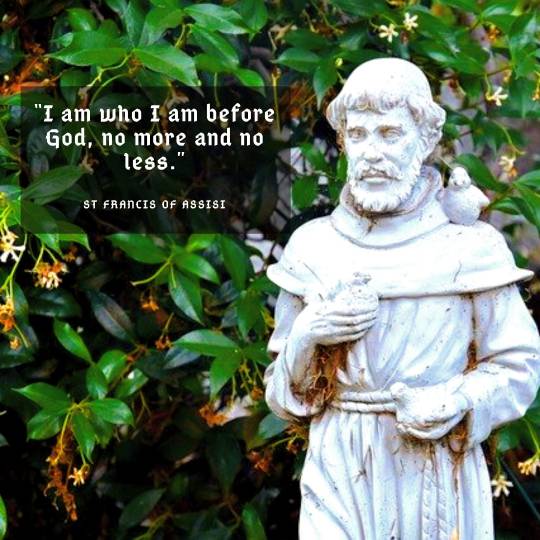
All too often we worry define who we are by our own standards or by how others define us, but what are we before God? True humility is needed to be holy in this world, and this means knowing how God sees us. It also means accepting what God wants us to be, rather than what the world wants us to be. Stay humble, and ask yourself who you are before God, because this is all that matters.
#catholic#catholic church#catholicism#catholic beliefs#catholic strength#roman catholic#catholic blog#catholic growth#catholic saints#st francis of assisi#st francis#saint#saints#saint quote
33 notes
·
View notes
